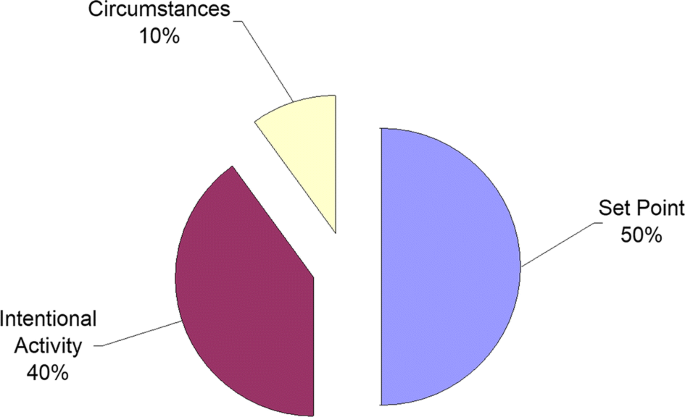“Three primary factors influencing the chronic happiness level” (Lyubomirsky et al. 2005, p.116)
In 2005 top positive psychology researchers – Lyubomirsky, Sheldon, and Schkade – proposed a relativity simple model of what determines happiness.
The researchers broke down the chart below – Circumstance refers to broader, external conditions surrounding life. Think income, living conditions, access to goods, etc. Set Point refers to genetic predisposition or the approximate level we are wired to fall into holding all else equal. Finally, the Intentional Activity piece refers to conscious efforts we can make to increase our well-being.
For the last 15 years, this framework has been the oft-quoted standard for determining happiness. Today, the general principle that intention is a key factor in improving happiness remains supported; however, the size of each ‘pie slice’ has changed. The last decade of research has shown that 40% intention is likely an over estimate. In fact, a study found that activity-based effects only accounted for 15% of variation in well-being (Klug & Maier, 2015). Only 15% of happiness is under our control? This seems discouraging — but there’s a catch.
These studies included large numbers of participants who were selected by researchers. Those who self-selected to take part in a happiness intervention obtained significant benefits across the board. Belief and will are a key piece of the puzzle. If we believe in our ability to change we increase the power of our intention.
Further, the impact of intention may not fit neatly in the “intentional activity” bucket. If we take action to improve our health, financial situation, social lives, and overall skills won’t it naturally bleed over into circumstances? Conversely, making changes to our environments and the systems we operate in can dramatically influence behavior. (If you’re skeptical try storing your phone in your backpack or another room for an afternoon and observe the difference in screen-time).
The bottom line remains the same – intention matters and it is the variable which we can most directly control. Intentional activity in itself may have less impact on happiness than we had originally thought, but its effects on circumstance (and thus happiness) can’t be overlooked. Further, we now understand that belief and will together are a necessity for positive change.
Find the research here.
References
Kennon M. Sheldon & Sonja Lyubomirsky (2019): Revisiting the Sustainable Happiness Model and Pie Chart: Can Happiness Be Successfully Pursued?, The Journal of Positive Psychology, DOI: 10.1080/17439760.2019.1689421
Klug, H. J. P., & Maier, G. W. (2015). Linking goal progress and subjective well-being: A meta-analysis. Journal of Happiness Studies: an Interdisciplinary Forum on Subjective Well-Being, 16 (1), 37–65

